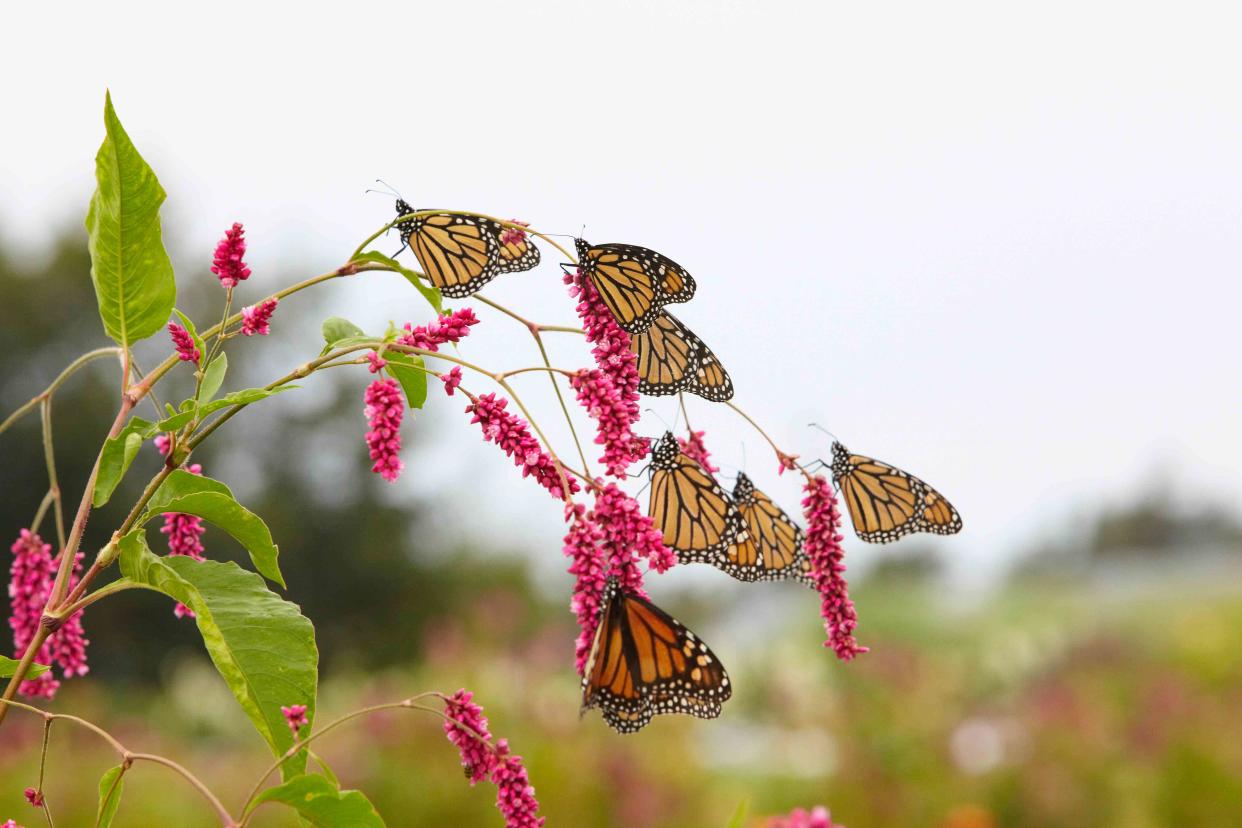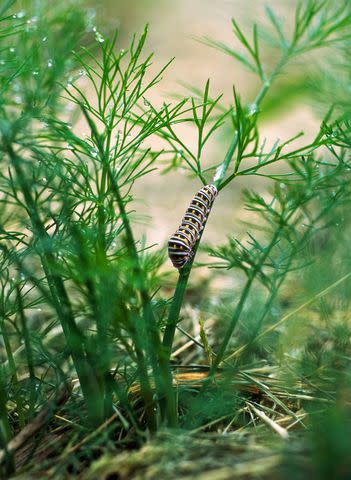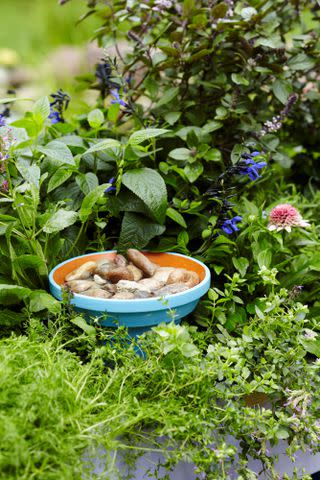How to Attract Butterflies to Your Garden: 6 Essential Elements to Provide
Find out how to attract butterflies with the right plants, water sources, and shelter.

Blaine Moats
It’s incredibly exciting to see butterflies with their colorful wings flitting around your garden. When you know how to attract butterflies, you can make these visits a regular occurrence. It just takes a little planning to create a garden that supports these insects at every stage of their life cycle—from eggs to caterpillars to adults. In return, these dazzling pollinators will boost the productivity of your garden and delight you with their vibrant presence.
1. Plant Native Plants
To turn your yard into a butterfly haven, start by planting native plants. These garden superstars attract more butterflies than non-native ornamentals because they’ve evolved alongside the butterflies. Many native plants are nectar-rich, feeding adult butterflies, while also supporting all life stages of butterflies, including eggs and caterpillars.
Asters, black-eyed Susans, coneflowers, and goldenrods are popular native plants that not only nourish adult butterflies but also serve as host plants for their caterpillars. Butterflies are selective about where they lay their eggs, choosing plants that will provide food for their caterpillars once they hatch.
Native plants also come in a huge variety of shapes, sizes, and colors, making it easy to find options that will perfectly fit your yard. As an added bonus, they require less maintenance, water, and fertilizer compared to non-native species since they’re naturally adapted to your local climate and soil conditions.
To keep butterflies visiting your garden all season long, choose a mix of plants that bloom at different times of the year. This approach ensures a constant food source for the butterflies while also providing you with a vibrant display of color from spring through fall. Additionally, plant flowers in groups rather than scattering them individually. Clusters of blooms are easier for butterflies to spot, increasing the chances they’ll visit your garden and stay longer to feed.
Tips
To attract specific species of butterflies to your garden, plant their preferred host plants: milkweed for monarchs, sunflowers and pearly everlasting for painted ladies, native violets for fritillaries, and Joe Pye weed and golden alexander for swallowtails.

Andy Lyons
2. Supplement with Annuals
While native plants should be the cornerstone of a butterfly garden, adding nectar-rich annuals can provide another vibrant and continuous food source throughout the growing season. Flowers like zinnias, cosmos, lantana, verbena, and sunflowers are butterfly magnets and bloom all summer long so they are useful for attracting butterflies when native plants aren’t in bloom.
In addition to providing nectar, some annuals also support caterpillars. For example, some swallowtail butterflies, particularly the black swallowtail, use plants in the parsley family as host plants. To help these butterflies, consider planting extra parsley, dill, fennel, and cilantro in your vegetable garden, and be prepared to share these herbs with hungry caterpillars.
Annuals are also extremely versatile—they can easily be planted in containers and hanging baskets, allowing you to create butterfly-friendly spots in even the smallest spaces. This allows you to experiment with different flower combinations each year to see what attracts the most butterflies and looks the best in your yard.
Related: The 17 Best Outdoor Planters of 2024
3. Offer Shelter
Butterflies need more than just flowers to thrive in your garden, they also need safe places to rest, hide from predators, and shelter from rain and wind. To create a butterfly-friendly yard, add plants that offer natural cover, such as tall grasses, shrubs, and even trees.
When integrating shelter into your yard, elect for native species. Clumping grasses like little bluestem and switchgrass provide low-level cover. Shrubs like ninebark, dogwood, and elderberry have dense branches that can block wind and provide cover for butterflies. Evergreens, such as the eastern red cedar, American holly, and eastern hemlock, are particularly effective at providing protective places for butterflies, especially when other plants have lost their leaves.

Jay Wilde
4. Add a Puddle
While nectar provides butterflies with most of their energy and water needs, it can lack many of the nutrients that butterflies need, such as salt and amino acids. Butterflies often find these missing nutrients in moist soil, where evaporating water leaves nutrients near the surface—this is why you often see butterflies gathering around puddles or damp soil.
Creating a butterfly puddle in your garden is an easy DIY project. Simply fill a shallow saucer with sand, mix in compost for added nutrients, and add just enough water to keep the sand moist and to form a shallow puddle. You can even add a few flat rocks for perching spots. Make sure to keep the soil moist, which may require you to add more water daily or every few days, depending on the weather.
Related: 11 Types of Water Features to Add a Refreshing Touch to Your Yard
5. Avoid Pesticides
If you want to attract and support butterflies in your garden, ditch pesticides. Many of these chemicals don’t differentiate between pests and beneficial insects and will kill the butterflies, bees, and other pollinators in your yard. Take mosquito sprays, for example—they might keep the skeeters at bay, but they also kill butterflies and bees.
Instead of applying chemicals, embrace natural pest management. Encourage natural predators, such as ladybugs, parasitic wasps, and spiders, to live in your garden and feed on other insects that may be damaging your plants. Physical barriers, such as row covers, can also prevent pests from reaching your plants. Planting a variety of native plants also helps create a strong, resilient garden that isn’t reliant on chemicals to thrive. And keep in mind that a few nibbled leaves are a small price to pay for a vibrant, butterfly-friendly space.
Related: 6 Ways to Get Rid of Aphids on Milkweed Without Harming Monarchs
6. Provide Overwintering Habitat
To support butterflies year-round, it's important to think beyond summer. Leaving some areas of your yard a little wild can create overwintering habitat for butterflies. In northern regions, many butterflies use leaf litter and dried plant matter to protect eggs, caterpillars, chrysalises, and adults throughout the cold winter months. Swallowtails overwinter in chrysalises attached to dried plant stems or tucked amongst leaf litter. Fritillary caterpillars burrow in leaf litter at the base of their host plants. Adult morning cloaks hibernate in cracks in tree bark, wood piles, or leaf litter.
To ensure that you’re providing butterflies with spaces where these beautiful creatures can hibernate during the colder months, let leaves, logs, and uncut plant stems remain in place in the fall. Then, in the spring, delay your garden cleanup to allow overwintering butterflies time to emerge safely. This way, your garden can continue to be a thriving sanctuary for butterflies throughout the year.
For more Better Homes & Gardens news, make sure to sign up for our newsletter!
Read the original article on Better Homes & Gardens.
